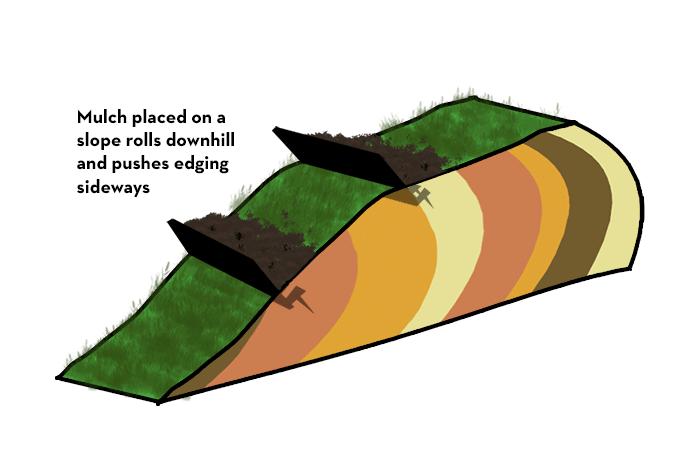Would you want your mulch edging to stay in place forever? So you don’t have to keep wasting time re-fixing your borders? Instead it’s time you spent your time admiring your garden and planting plants that will get you the pride in your garden you desire. Read on to set your mulch edging up JUST ONCE and have it stay for a long time.

Mistakes to avoid keeping mulch edging from washing away
Below are a series of points you want to make sure you are doing correctly to get the mulch edging to stay functioning for a long time.
Buying low quality mulch edging that breaks
Sometimes low quality edging can crack in colder temperature in the winter months and that is why it is easy for mulch to wash away.
The material cracks by freezing and thawing creating temperature extremes that reduce the strength of the chemical bonds.
Sometimes, water can also get inside small holes in the plastic and as it freezes it expands and create cracks in the edging.
You want to avoid plastics such as polystyrene for mulch edging if you know you have cold winters.
If the mulch edging you buy seems brittle, consider purchasing something else.
Likewise, in the summer, prolonged exposure to the suns UV rays can weaken plastic overtime.
Look for good reviews if you buy your edging online or make sure you read the packaging of your edging to make sure it is suitable to stay outside in the winter. A great place to compare review is on Amazon
Staking the edging spikes not deep enough in to the soil
When you buy a mulch edging kit, they will sometimes come with holes at the base and stakes so you can drive the stakes through the holes and into the soil.
Doing a poor job at this could result in your stakes going in to the soil at a funny angle or not deep enough to resist and pressure. Make sure you read up on exactly how to install plastic mulch edging so you don’t make silly mistakes like this or worse.
Make sure you buy a heavy enough rubber mallet or hammer to drive those stakes into the ground where they should stay. Like this one:
Using incorrect edging for your soil and mulch
Sometimes, the type of soil you are using as well as the shape and depth of the edge means you have to change the type of mulch edging.
Also, if you are adding a lot of heavy mulch in to your garden, using an edging that is more sturdy such as concrete blocks, stones or wooden pillars could be preferred.
This is due to plastic edging bending under the weight of a lot of soil and potentially bending out of place overtime
Use stronger mulch edging if
- You have a deep patch of mulch to edge
- The mulch you are using is particularly heavy
- The ground is already unstable with a lot of gravel
Laying mulch edging near or around downspouts
This may seem obvious but there is nothing much you can do about mulch edging washing away near a constant source of strong running water.
Place your edging away from your gutter or any main routes water takes in your outdoor space or read up on keeping mulch from washing away around your downspouts.
Alternatively. create a hinged downspout extension so your downspout runoff comes out away from your mulch.
Not compacting your soil enough
When you install your mulch edging, the soil you lay it in to may already be quite full with air pockets.
For example if you recently laid down some fresh compost this may be unstable and disconnected from the more stable soil below.
To ensure your much edging doesn’t become detached, compress the soil by standing on it or patting it with a garden spade beforehand
Installing mulch edging on a steep slope
Mulch edging that is holding back a large amount of soil or mulch above it will likely collapse due to the pressure on it due to gravity
Edging shouldn’t be used as a border to stop soil “rolling” down a slope. But rather as a border to stop soil “spilling” sideways
Think of mulch edging being best used to separate two level surfaces rather than hold back two sloped surfaces

Having said that, it is perfectly fine if one of the surfaces is slightly above another. As long as both surfaces are flat and the edging isn’t staked into the ground at an angle on a slope.
Installing mulch edging around stones
If you install you edging around stones, the stones can become easily dislodged and move your edging around with a small amount of water movement or pressure.
Also it will be hard to push the stakes of your barrier deep enough in to the ground as they will likely hit a stone and not go in any further.
If you find that a lot of your outdoor space has a lot of stones then you should remove as many of the large ones as you can
Then add soil or compost and compact it down by standing on it or patting it before you put in your mulch edging


